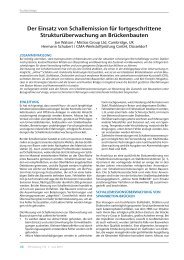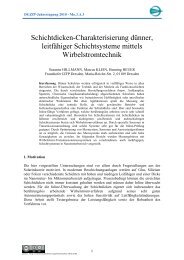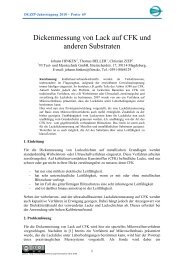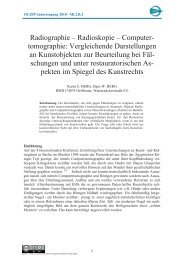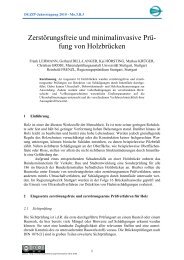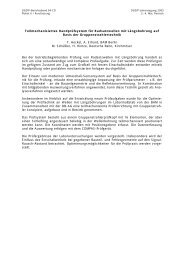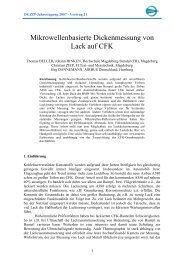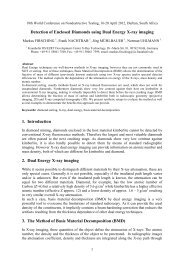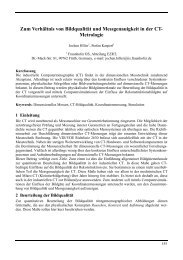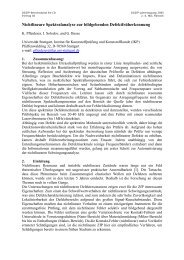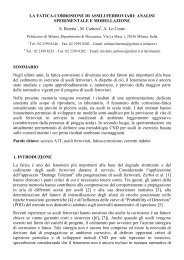The Early Use of Prussian Blue in Paintings - NDT.net
The Early Use of Prussian Blue in Paintings - NDT.net
The Early Use of Prussian Blue in Paintings - NDT.net
You also want an ePaper? Increase the reach of your titles
YUMPU automatically turns print PDFs into web optimized ePapers that Google loves.
Cross sections were <strong>in</strong>vestigated by microscopy us<strong>in</strong>g visible and UV light (Leica DMLM<br />
microscope), and some by electron microscopy (REM-EDX, Hitachi S-2700).<br />
A paragon 1000PC FTIR spectrometer (Perk<strong>in</strong> Elmer), <strong>in</strong> comb<strong>in</strong>ation with an i-series FTIR<br />
microscope (Perk<strong>in</strong> Elmer), was used for <strong>in</strong>frared spectroscopy <strong>in</strong> transmission mode.<br />
Samples were pressed on a diamond. <strong>The</strong> IR spectrum <strong>of</strong> <strong>Prussian</strong> blue shows a characteristic<br />
band at 2083 cm -1 due to the C-N stretch vibration [Berrie].<br />
EARLY PRUSSIAN BLUE - HISTORICAL SOURCES<br />
<strong>Prussian</strong> blue is first mentioned <strong>in</strong> a letter written by Johann Leonhard Frisch (1666-1743) to<br />
the president <strong>of</strong> the Royal Academy <strong>of</strong> Sciences, Gottfried Wilhelm Leibniz (1646-1716),<br />
from March 31, 1708 [Frisch]. <strong>The</strong> pigment was also an important topic <strong>in</strong> other letters <strong>of</strong><br />
their correspondence between 1708 and 1716. By August 1709, the pigment had been termed<br />
"Preussisch blau"; by November 1709, the German name "Berl<strong>in</strong>isch Blau" had been used for<br />
the first time [Frisch].<br />
Although Frisch was not the <strong>in</strong>ventor <strong>of</strong> the pigment, he could be considered to be someone<br />
we would today call a product manager. He claimed to have improved the pigment, e.g. by<br />
means <strong>of</strong> an acid treatment [Frisch]. He was very active <strong>in</strong> promot<strong>in</strong>g and sell<strong>in</strong>g the pigment.<br />
Frisch himself is the author <strong>of</strong> the first known publication <strong>of</strong> <strong>Prussian</strong> blue <strong>in</strong> the paper<br />
“Notitia Coerulei Berol<strong>in</strong>ensis nuper <strong>in</strong>venti” <strong>in</strong> 1710 [Frisch 1710], as can be deduced from<br />
his letters [Bartoll et al.]. <strong>The</strong> publication gives <strong>in</strong>formation on the availability <strong>of</strong> the pigment<br />
at the booksellers <strong>of</strong> the Royal Academy <strong>of</strong> Sciences <strong>in</strong> Berl<strong>in</strong>.<br />
Three historical sources mention Diesbach as the actual <strong>in</strong>ventor <strong>of</strong> the pigment [Frisch;<br />
Stahl; Berger]. Diesbach had been work<strong>in</strong>g for Frisch s<strong>in</strong>ce about 1701 [Frisch]. <strong>The</strong>re is<br />
much confusion <strong>in</strong> literature about Diesbach’s first name. Most historical sources do not<br />
mention a first name at all. Only Berger refers to him as Johann Jacob Diesbach [Berger].<br />
In 1731, Stahl published a story deal<strong>in</strong>g with the <strong>in</strong>cidence <strong>of</strong> the first synthesis <strong>of</strong> <strong>Prussian</strong><br />
blue [Stahl]. <strong>The</strong> story <strong>in</strong>volves not only Diesbach but also Johann Conrad Dippel. No other<br />
known historical source mentions Dippel <strong>in</strong> this context. It is therefore difficult to judge the<br />
reliability <strong>of</strong> this story today.<br />
<strong>The</strong>re is also much confusion regard<strong>in</strong>g the date <strong>of</strong> the discovery. Textbooks and<br />
encyclopaedia <strong>of</strong>ten give the year as 1704 <strong>in</strong> this context. However, they fail to give the<br />
source <strong>of</strong> this date. Harley suggests a conjectured date for the discovery between 1704 and<br />
1707, as this was the period when Dippel was liv<strong>in</strong>g <strong>in</strong> Berl<strong>in</strong> [Harley]. Frisch wrote <strong>in</strong> his<br />
letter from March 31, 1708, that he had already made some money with the pigment [Frisch].<br />
This suggests that the discovery must have taken place some time before 1708. <strong>The</strong> pigment,<br />
however, is not mentioned <strong>in</strong> his letters to Leibniz from 1706 and 1707. It seems to be<br />
feasible that this period <strong>in</strong> time <strong>in</strong>cludes the day <strong>of</strong> discovery and the process <strong>of</strong> a secret<br />
experimentation <strong>in</strong> order to develop a market-ready product. Accord<strong>in</strong>g to Berger, <strong>Prussian</strong><br />
blue was developed by Diesbach <strong>in</strong> 1706 [Berger; Brather]. All <strong>in</strong> all, it seems that <strong>Prussian</strong><br />
blue was synthesised for the first time around 1706 by Johann Jacob Diesbach <strong>in</strong> Berl<strong>in</strong>.<br />
Not later than 1709, Frisch and also Joseph Werner, the director <strong>of</strong> the Royal Academy <strong>of</strong><br />
Arts <strong>in</strong> Berl<strong>in</strong>, began send<strong>in</strong>g samples <strong>of</strong> <strong>Prussian</strong> blue to a number <strong>of</strong> pa<strong>in</strong>ters across Europe<br />
[Frisch]. Wolfenbüttel, Leipzig, Basel, Paris and Italy are all mentioned <strong>in</strong> this context.<br />
4



